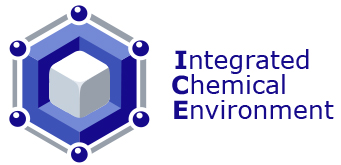ICE: Integrated Chemical Environment
Successful computational toxicology projects depend on high-quality data that are freely available and formatted for use in computational workflows. The Integrated Chemical Environment (ICE) addresses the data needs frequently expressed by NICEATM stakeholders. Launched in March 2017, ICE provides curated data from NICEATM, its partners, and other resources, as well as tools to facilitate the safety assessment of chemicals. An article published in November 2022 in Frontiers in Toxicology (Daniel et al. 2022) provides the most recent detailed overview of ICE.
NICEATM will offer a hands-on training session on ICE data and tools on Wednesday, May 22 at the National Institutes of Health in Bethesda, MD. This session is in-person only, and registration is required to attend.
In October 2023, NICEATM presented a continuing education course, "Open-access Data and Computational Tools to Investigate Chemical Bioactivity", at the annual meeting of the American Society for Cellular and Computational Toxicology. Presentations discussed data and tools available in the Integrated Chemical Environment, as well as the NICEATM tools ChemMaps and DASS App.
In March 2024, NICEATM released ICE 4.0.2, which implemented these features:
- New data visualizations for Search tool query summary results.
- Updated filter chain options in Search
- New overlays for data comparisons in the In Vitro to In Vivo Extrapolation (IVIVE) tool.
- Curve Surfer tool optimization.
- Updated cHTS data from the Invitrodb v3.5 release.
- Improved support for chemical name searching in the ICE REST API.
A training event organized by PCRM shortly after the ICE 3.6 update featured NICEATM developers demonstrating how to use ICE tools for data and assay exploration. Videos from the training are available on the PCRM website.
Several posters presented at the 2024 annual meeting of the Society of Toxicology describe features in ICE 4.0.2 or to be included in future ICE releases:
- Hill et al. (Computational Toxicology II session): "Incorporating Ontologies into High Throughput Screening Assay Annotations to Increase Data Use and Interpretation"
- Hull et al. (New Approach Methods: Computational session): "Curating Chemical Use Categories and Exposure Predictions to Inform Chemical Assessment"
- Maxwell et al. (New Approach Methods: General session): "Application of Skin Allergy Risk Assessment-Integrated Chemical Environment Defined Approach (SARA-ICE DA) to Assess Skin Sensitization Potency of Isothiazolinone Compounds"
- Reinke et al. (New Approach Methods: Computational session): "Application of the SARA-ICE Skin Sensitization Defined Approach to a Diverse Chemical Set - a Comparative Case Study"
ICE Data and Curation
ICE includes data from animal and non-animal tests that measure toxic effects described in chemical safety regulations. These effects include acute oral toxicity, skin and eye irritation, skin sensitization, and endocrine activity. ICE also contains curated HTS data from the EPA ToxCast program and the Tox21 consortium and physicochemical property data about chemicals including solubility, melting point, and molecular weight.
Inclusion of data from (Mansouri et al. 2018) means that ICE tools can utilize predictions of physicochemical and ADME properties and toxicity endpoints for thousands of chemicals lacking experimental data. ICE REST APIs, implemented in version 3.7 (July 2022), allow users to access ICE data more easily via database searches outside of the ICE graphical user interface environment.
Curation by NICEATM of all data that go into ICE (described in Daniel et al. 2022) is paramount to ensuring that robust data are available to users. NICEATM staff critically curate, review, and harmonize all ICE data. Curation of HTS data for ICE first retrieves Tox21 and ToxCast data from EPA’s invitrodb, which houses all HTS data analyzed using the ToxCast Pipeline (tcpl) package. NICEATM then applies curation steps to minimize low-confidence hit calls, providing a processed version of the HTS data, referred to as cHTS, that is ready for any application. Factors considered in the curation include chemical purity, quality control data, concentration-response curve fits, and testing range. To facilitate targeted access of cHTS data by ICE tools, NICEATM also maps assay endpoints to mechanistic targets, facilitating interpretation of assay readouts based on biological processes, and to modes of action relevant to toxicity endpoints of regulatory concern.
ICE Tools
The ICE Search tool enables users to easily query and integrate data streams and explore the results interactively. Population-level exposure predictions across multiple pathways were added to ICE Search results in 2023.
Assays selected in one ICE tool can be used to query other ICE tools. Various ICE tools support uploads of custom data, results visualizations, and results filtering options. Outputs provide publication-quality graphics and downloadable data files.
ICE IVIVE and PBPK tools leverage EPA’s High-throughput Toxicokinetics (httk) package to provide users with an approachable, easy-to-use interface for running analyses. Users can leverage curated datasets in ICE or upload their own data. Furthermore, the IVIVE outputs can be visualized with in vivo or predicted exposure data overlays to provide additional context to results.
The ICE Chemical Quest tool conducts chemical similarity searches based on Saagar fingerprints (Sedykh et al. 2021) to help ICE users identify similar chemicals based on their own input chemicals. This tool allows users to draw novel structures or in put any chemical descriptor as input. The ICE Chemical Characterization tool allows the user to comprehensively evaluate a chemical or chemical list or compare two chemical lists, and review their chemicals' physicochemical properties, chemical product use information, and bioactivity across cHTS data backgrounds. The 2023 4.0.1 update replaced the "Consumer Use Explorer" with the more comprehensive "Curated Product Use Explorer" and added functional use categories to the Chemical Characterization output.
For more information about ICE, email [email protected] or visit the ICE About page.


